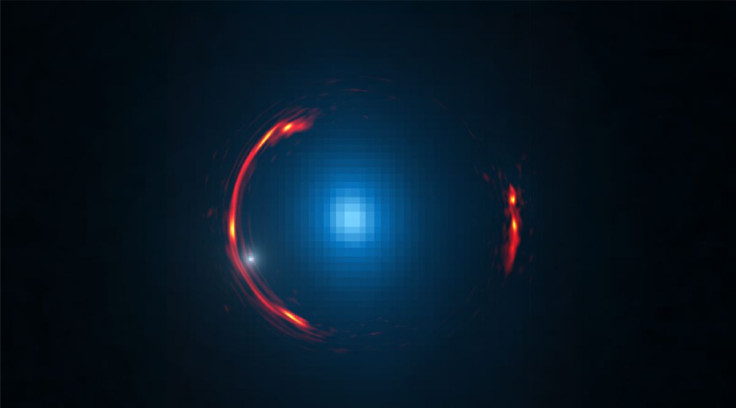Distant Space-Time Warp May Be Hiding Clues To Composition Of Dark Matter

In October 2014, the Atacama Large Millimeter/submillimeter Array (ALMA) in Chile observed a near-perfect example of what scientists call an “Einstein Ring” — created when the gravity of a massive foreground galaxy or black hole bends the light emitted by a distant source. In this particular instance, the foreground object was a galaxy named HATLAS J090311.6+003906, or SDP.81 in short, located four billion light-years from Earth, while the distant source was another galaxy 12 billion light-years away.
Now, in a new paper accepted for publication in the Astrophysical Journal, scientists argue that subtle anomalies in the gravitational distortion of the distant galaxy may hold clues to composition of the ever so enigmatic dark matter.
Dark matter, as the name suggests, is dark, except when it emits high-frequency gamma rays during collisions with other dark matter particles. As of now, very little is known about this exotic matter that makes up 85 percent of all matter in the universe.
While scientists have long been hunting for clues to its composition, the fact that it does not emit or absorb any radiation and interacts with visible matter only through gravity makes it next to impossible to detect and study.
However, dark matter does have appreciable mass, and can, therefore, be identified by the gravitational influence it exerts on neighboring objects.
After carrying out a detailed analysis of the lensing galaxy’s halo, researchers found that an invisible dwarf galaxy — less than one-thousandth the mass of the Milky Way and most likely packed with dark matter — is situated right next to the more massive galaxy, and is causing distortions in the Einstein ring.
ALMA_StrongLensing_SDP81_NRAO from NRAO Outreach on Vimeo.
Scientists believe that thousands of such “satellite objects,” made mostly of dark matter, are located even around our own galaxy, although only about 40 have so far been identified.
“This discrepancy between observed satellites and predicted abundances has been a major problem in cosmology for nearly two decades, even called a 'crisis' by some researchers,” co-author Neal Dalal from the University of Illinois, said in a statement released Thursday. “If these dwarf objects are dominated by dark matter, this could explain the discrepancy while offering new insights into the true nature of dark matter.”
© Copyright IBTimes 2025. All rights reserved.






















